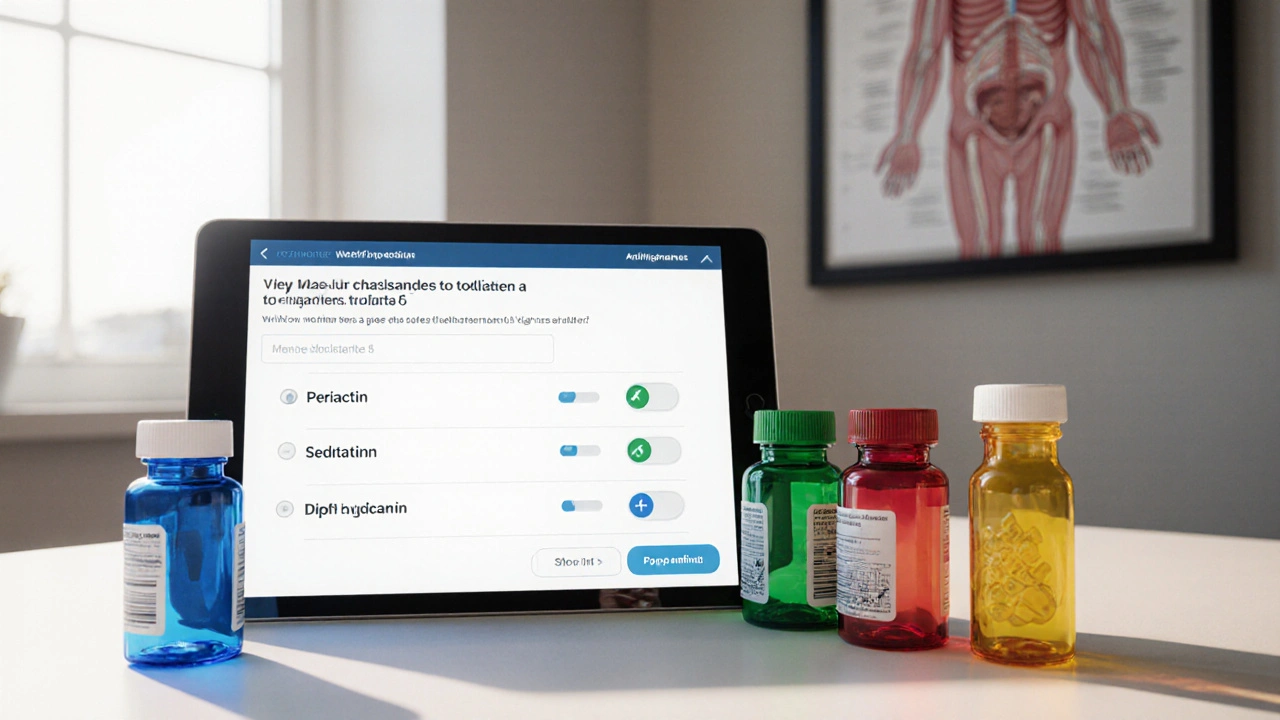Antihistamine Choice Advisor
Your personalized recommendation will appear here after answering the questions.
When you or a loved one needs relief from allergy symptoms, itch, or appetite loss, the brand name Periactin is often mentioned. Its generic name, Cyproheptadine, is a first‑generation antihistamine that also acts as a serotonin antagonist, giving it a unique set of uses beyond typical allergy relief. But is it the right choice compared with today’s newer antihistamines? This guide breaks down how Periactin stacks up against the most common alternatives, so you can decide what fits your health needs.
TL;DR
- Periactin works quickly for allergy itching and can boost appetite, but it often causes drowsiness.
- Second‑generation antihistamines (Loratadine, Cetirizine) offer less sedation with similar allergy control.
- Diphenhydramine provides strong short‑term relief but is best for occasional use due to heavy sedation.
- For chronic itching or migraine prevention, Doxepin or Hydroxyzine may be more appropriate.
- Choose Periactin if you need appetite stimulation or have severe itching that newer agents don’t control.
What Is Periactin (Cyproheptadine)?
Cyproheptadine is a first‑generation antihistamine approved by the FDA in 1961. It blocks the H1 histamine receptor, reducing the release of inflammatory mediators that cause itching, sneezing, and watery eyes. Unlike many modern antihistamines, it also antagonizes serotonin (5‑HT2) receptors, which explains its appetite‑stimulating effect and occasional off‑label use for migraine prophylaxis.
Typical adult dosing for allergy relief is 4mg once or twice daily, while the appetite‑stimulating dose can go up to 20mg per day, split into several doses. Periactin is prescription‑only in the United States but is available over the counter in a few European countries.
How Cyproheptadine Works Compared to Newer Antihistamines
First‑generation antihistamines like Cyproheptadine cross the blood‑brain barrier, which is why they tend to make users sleepy. Second‑generation agents (Loratadine, Cetirizine, Fexofenadine) are designed to stay peripheral, limiting central nervous system effects. This difference drives the core trade‑off: sedation versus broader receptor activity.
Because Cyproheptadine also blocks serotonin receptors, it can increase appetite and has modest anti‑migraine properties-effects you won’t see with most newer drugs.
Key Attributes of Periactin
- Indications: Seasonal allergic rhinitis, chronic urticaria, itching from dermatologic conditions, appetite stimulation, off‑label migraine prevention.
- Onset: 30-60minutes for allergy relief; appetite effects may take several days.
- Half‑life: 8-12hours, requiring once‑ or twice‑daily dosing.
- Side‑effects: Drowsiness, dry mouth, weight gain, dizziness, possible anticholinergic effects.
- Drug interactions: Potentiates CNS depressants, may interfere with monoamine oxidase inhibitors (MAOIs) and other serotonergic agents.
Top Antihistamine Alternatives
Below are the six most frequently considered alternatives, each with its own strength.
Diphenhydramine (Benadryl) - a classic first‑generation antihistamine known for strong sedation, making it useful for nighttime allergy relief or short‑term insomnia.
Loratadine (Claritin) - a second‑generation antihistamine offering 24‑hour relief with minimal drowsiness.
Cetirizine (Zyrtec) - slightly more sedating than Loratadine but provides rapid onset, often within an hour.
Fexofenadine (Allegra) - virtually non‑sedating, good for active adults who can’t afford a ‘tired’ feeling.
Doxepin - a tricyclic antidepressant with potent H1 blockade, used for chronic urticaria and atopic dermatitis when itching is severe.
Hydroxyzine - an antihistamine with anxiolytic properties, often chosen for pre‑operative sedation and severe itching.

Comparison Table: Periactin vs Six Common Alternatives
| Drug | Generation | Typical Dose | Onset | Duration | Sedation Level | OTC? | Special Uses |
|---|---|---|---|---|---|---|---|
| Periactin (Cyproheptadine) | First | 4‑20mg/day | 30‑60min | 8‑12hr | Moderate‑High | Prescription (US) | Appetite stimulant, migraine prophylaxis |
| Diphenhydramine | First | 25‑50mg q6‑8h | 15‑30min | 4‑6hr | High | OTC | Sleep aid, motion sickness |
| Loratadine | Second | 10mg q24h | 1‑3hr | 24hr | Low | OTC | Allergy, hives |
| Cetirizine | Second | 10mg q24h | ~1hr | 24hr | Low‑Moderate | OTC | Allergy, chronic urticaria |
| Fexofenadine | Second | 180mg q12h | 1‑2hr | 12‑24hr | None | OTC | Sports‑related allergies |
| Doxepin | Third (tricyclic) | 10‑25mg qHS | 2‑4hr | 12‑24hr | Moderate | Prescription | Severe itching, atopic dermatitis |
| Hydroxyzine | First | 25‑100mg q6‑8h | 15‑30min | 4‑6hr | Moderate‑High | Prescription | Pre‑op sedation, anxiety, itching |
When to Choose Periactin Over the Alternatives
If you need a medication that can do more than just block histamine-like boosting appetite in patients with cancer‑related cachexia or providing an extra edge in migraine prevention-Periactin often wins. Its dual antihistamine/serotonin antagonism is unmatched by second‑generation agents.
However, if daytime alertness is critical (e.g., you drive for a living or need to stay focused at work), a low‑sedation option like Loratadine or Fexofenadine is usually a better fit. For short‑term allergy spikes, Diphenhydramine can be handy at night, but daily reliance may lead to tolerance and a “hangover” feeling.
Patients with a history of depressive disorders should avoid Doxepin unless a psychiatrist prescribes it, while Hydroxyzine may be preferable when anxiety co‑exists with itching.
Safety, Side‑Effects & Drug Interactions
All antihistamines share a core side‑effect profile: dry mouth, constipation, and possible urinary retention in older adults. First‑generation drugs-Periactin, Diphenhydramine, Hydroxyzine-add a higher risk of drowsiness and impaired coordination.
Cyproheptadine’s serotonin antagonism can intensify the effects of SSRIs, SNRIs, or MAOIs, potentially leading to serotonin syndrome. Always alert your prescriber if you’re on any mood‑modulating meds.
Second‑generation agents are metabolized mainly by CYP3A4 (Loratadine, Fexofenadine) or CYP2D6 (Cetirizine). Strong inhibitors of these enzymes (e.g., ketoconazole, fluoxetine) can raise drug levels and increase side‑effects.
Pregnant or breastfeeding individuals should consult a healthcare professional before starting any antihistamine. Generally, Loratadine and Cetirizine have the most pregnancy‑friendly data, while Periactin is categorized as C and should be used only if benefits outweigh risks.
Practical Decision Checklist
- Do you need appetite stimulation or migraine prophylaxis? → Consider Periactin.
- Is daytime sedation a deal‑breaker? → Choose a second‑generation agent (Loratadine, Fexofenadine).
- Do you need rapid relief for a sudden flare? → Diphenhydramine or Hydroxyzine work fast.
- Is severe chronic itching your primary concern? → Doxepin or high‑dose Cetirizine may be best.
- Are you on antidepressants or other serotonergic drugs? → Avoid Cyproheptadine unless a doctor monitors closely.
Bottom Line: Match the Drug to Your Specific Need
There’s no one‑size‑fits‑all antihistamine. Periactin shines when you need that extra serotonin‑blocking boost for appetite or migraine, but you’ll pay the price in drowsiness. Newer, second‑generation drugs keep you awake but lack those niche benefits. Use the checklist above, talk with your clinician about current meds, and pick the option that aligns with your lifestyle and symptom profile.
Frequently Asked Questions
Can Periactin be used for weight gain?
Yes. Because Cyproheptadine blocks serotonin receptors, it often stimulates appetite and can lead to modest weight gain. Doctors sometimes prescribe it off‑label for patients with cancer‑related cachexia or severe under‑nutrition, but dosage must be carefully managed.
Is Periactin safe for children?
Pediatric use is limited. The FDA approves Cyproheptadine for children over 2years for allergy symptoms, but the appetite‑stimulating dose is generally reserved for older children under close supervision. Side‑effects like sedation and paradoxical hyperactivity are more common in kids.
How does Periactin compare to Zyrtec for chronic urticaria?
Both can control chronic hives, but Periactin often works faster when itching is severe because of its stronger H1 blockade. However, Zyrtec (Cetirizine) is less sedating, making it a better daily option for most patients who can tolerate a slightly lower potency.
Can I take Periactin with an SSRI?
Combining Cyproheptadine with SSRIs can increase the risk of serotonin syndrome-a rare but serious condition. If a doctor deems it necessary, they will monitor for symptoms like agitation, fever, or rapid heart rate and may adjust dosages.
Which antihistamine is best for night‑time allergy relief without feeling groggy in the morning?
Diphenhydramine is a common choice because its sedative effects wear off after 4‑6hours, often leaving you refreshed by morning. An alternative is a low‑dose Periactin taken early in the evening, but the risk of lingering drowsiness is higher.


Alan Kogosowski
First‑generation antihistamines such as cyproheptadine occupy a unique niche in the pharmacologic armamentarium because they engage both H1 receptors and serotonin (5‑HT2) receptors, a duality that confers both antihistaminic and appetite‑stimulating properties.
When a patient presents with refractory pruritus, the clinician often finds that second‑generation agents like loratadine fail to provide sufficient relief due to their peripheral selectivity.
Cyproheptadine, by contrast, readily crosses the blood‑brain barrier, delivering central antihistaminic activity that can blunt the itch‑scratch cycle more effectively.
Its pharmacokinetic profile, characterized by an 8‑12 hour half‑life, permits once‑ or twice‑daily dosing, which is convenient for patients who struggle with multiple daily administrations.
The appetite‑stimulating effect arises from serotonin antagonism, which reduces satiety signals in the hypothalamus, thereby promoting increased caloric intake, a feature particularly valuable in oncology or gastro‑intestinal wasting syndromes.
However, this central penetrance is a double‑edged sword, as it also predisposes patients to sedation, anticholinergic side effects such as dry mouth, and occasionally paradoxical hyperactivity in children.
From a drug‑interaction standpoint, cyproheptadine inhibits CYP2D6 modestly, and when combined with serotonergic agents like SSRIs or SNRIs, there is a theoretical risk of serotonin syndrome, mandating vigilant monitoring.
Clinical guidelines suggest reserving cyproheptadine for cases where appetite augmentation or migraine prophylaxis is a priority, rather than as a first‑line choice for uncomplicated allergic rhinitis.
In terms of efficacy, several head‑to‑head trials demonstrate that cyproheptadine achieves a statistically significant reduction in wheal‑and‑flare responses compared with cetirizine, albeit with a higher incidence of daytime drowsiness.
Patients who operate heavy machinery or drive long distances should be counseled to avoid dosing during work hours and consider a lower evening dose to mitigate functional impairment.
The drug’s safety profile remains acceptable in adults, with most adverse events being mild and reversible upon discontinuation.
Nevertheless, in the elderly population, the anticholinergic burden can exacerbate urinary retention and cognitive decline, urging clinicians to weigh benefits against these geriatric risks.
In pediatric practice, cyproheptadine is approved for children over two years for allergy symptoms, but the appetite‑stimulating dose is off‑label and should only be employed under specialist supervision.
Overall, the decision matrix for cyproheptadine involves balancing its unique serotonergic benefits against the well‑documented sedative and anticholinergic drawbacks, a calculus that must be individualized to each patient’s therapeutic goals and lifestyle constraints.